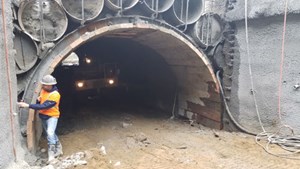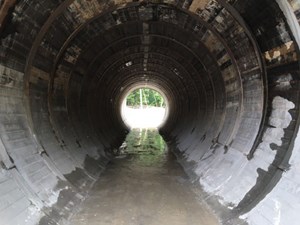September 2019 Vol. 74 No. 9
Features
Canopy Pilot-Tubes Provides Unique Project Solution
Jeff Griffin | Senior Editor
Installing pipelines or utilities beneath active roadways is always a challenge. Highway departments are concerned that excavations beneath their roadways could settle or create sinkholes in the roadway alignment, damaging the road. Owners of facilities don’t want heavy weight and vibration of road traffic passing overhead to damage them.
LRL Construction recently completed a project to replace a failing 6-foot-diameter corrugated steel drainage pipe under a busy two-lane U.S. Highway 101 in Manzanita, OR, a scenic, seaside village on the Pacific Ocean in the northwest part of the state.
To construct the new tunnel, LRL installed an underground canopy system consisting of 36-inch-diameter steel pipes installed by the jack-and-bore pilot tube method.
“As far as we know,” said CharDee Richey, assistant project manager for LRL Construction, “this is the first time this method has been used for this type of application.”
The project owner was the Oregon Department of Transportation (ODOT). Engineers for the project were ODOT and Randy Zeiger. LRL assisted in the design of the project.
Design
The canopy consisted of 14, 144-foot-long canopy tubes of 36-inch-diameter, schedule-120 steel, ultimately creating an opening 11-feet tall by 15-feet wide for the safe passage of migrating salmon and steel head in Neahkahne Creek.
The pilot tube procedure provides many of the advantages of conventional microtunneling for installing small-diameter pipes at short distances, at significantly lower costs than microtunneling installations of larger-size pipes.
Unlike conventional microtunneling, a pilot tube method establishes line and grade by installing a small-diameter pilot tube before the canopy pipe is jacked into place. The hollow pilot tube provides the optical path for the theodolite (a surveying instrument with a rotating telescope for measuring horizontal and vertical angles) to display head position and orientation for steering the path of the tube.
For the Manzanita canopy project, LRL mounted an Akkerman guided boring unit on an American Augers 36/42 600E auger boring machine with 29,500-foot/pounds of torque and 300 tons of thrust, supported by a Link Belt 350X3 excavator.
“After initial excavating and moving some 18,000 cubic yards of material,” said Richey, “the canopy system was started roughly 50 feet below Highway 101 in what we called the ‘pit’ which was 84 feet wide, 50 feet deep with a 250-foot-long access ramp.
“With the sandy formation in the target area, the decision was made to build a leveling slab to create a solid, stable platform to set up the auger boring machine with pilot tube guidance system.”
A pilot tube was initially drilled through for line and grade, and once the correct line and grade were established, the pilot tube was “chased” by the 36-inch diameter steel pipe and attached to an exterior grout tube.
“The steel pipe,” continued Richey, “is pushed with material inside the pipe and cleaned out with machine augers. This proceeded in 20-foot sections that are welded together to extend a 36-foot pipe and exterior grout tube, and once again an auger removed materials that were generated.” Material was removed with the Link Belt 350X3 excavator and loaded into dump trucks and hauled to a local permitted fill site.
Construction of the canopy continued from the bottom, alternating sides to gradually change alignment to achieve the desired arch formation. Once the canopy arch was complete, the crew then used cutting torches to cut holes through adjoining pipes, bolting them together with hardened bolts.
Grout
After bolting was completed, exterior tubes were grouted with a neat cement grout. The grout tube was withdrawn when grout reached specified quantities.
“Grouting,” Richey said, “seals any small openings between canopy tubes. This step is repeated until all seams between pipes have been grouted.”
When a grout seal was in place, the material inside the canopy was excavated to the specified elevation. Material was removed inside the canopy system with a Takauchi 135 mini excavator, loaded into a Marooka wide-track haul truck, then transferred to dump trucks with the LinkBelt excavator and hauled to the permitted fill sites.
The final tunnel lining system was a “U”-shaped rib and lagging tunnel, approximately 140 feet long. The rib and lagging system consisted of W8x58 ribs at 4-foot centers with fiber-reinforced shotcrete in-between the bays. The invert of the tunnel consisted of 8x58 floor struts at 4-foot centers with fiber-reinforced shotcrete to provide a flat bottom.
“The final step,” said Richey, “was the installation of a gravel stream bottom with fish rock and tree structures added to make it a suitable fish habitat, and the diverted stream reintroduced to the new alignment for the new fish passage.”
Installation of the canopy was completed in six weeks. The total project was finished in five months.
Based in Tillamook, OR, LRL Construction specialties include tunnel rehabilitation and enlargement, soil stabilization, rockfall mitigation, shaft construction, shotcrete, culvert installation, soil nail and rock bolting and tunnel assessment. The company is known for fast response to natural and man-caused disasters and most types of construction emergencies. •
FOR MORE INFORMATION:
LRL Construction, (503) 842-5520, lrlconstruction.com
American Augers, (800) 324-4930, americanaugers.com
Akkerman Inc., (800) 533-0386, akkerman.com






Comments